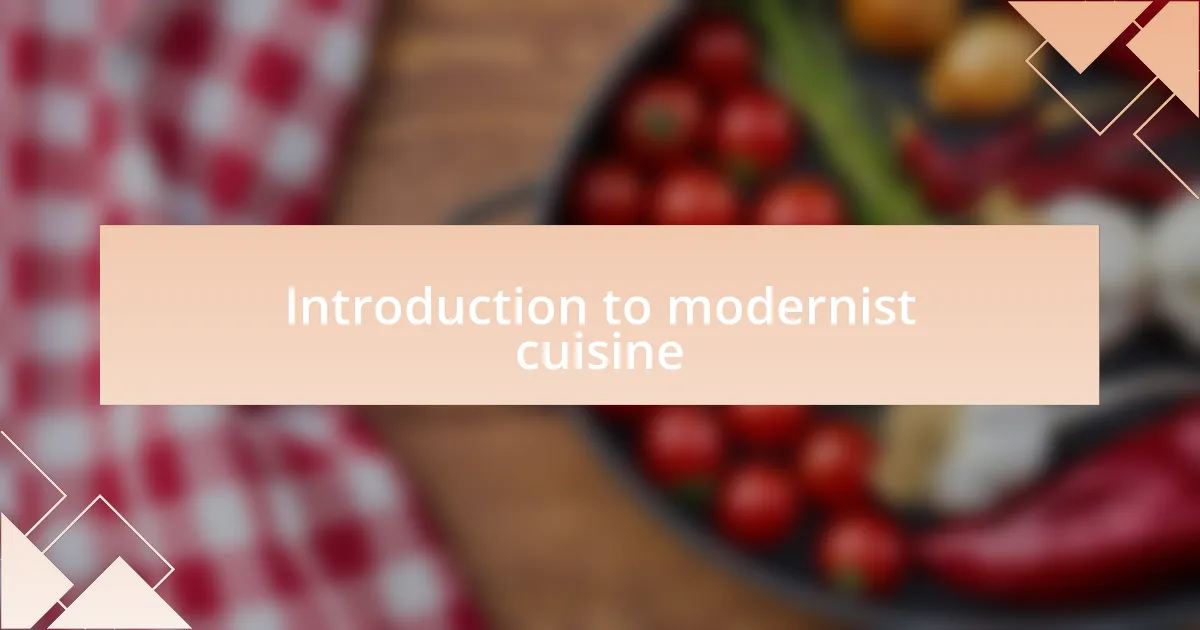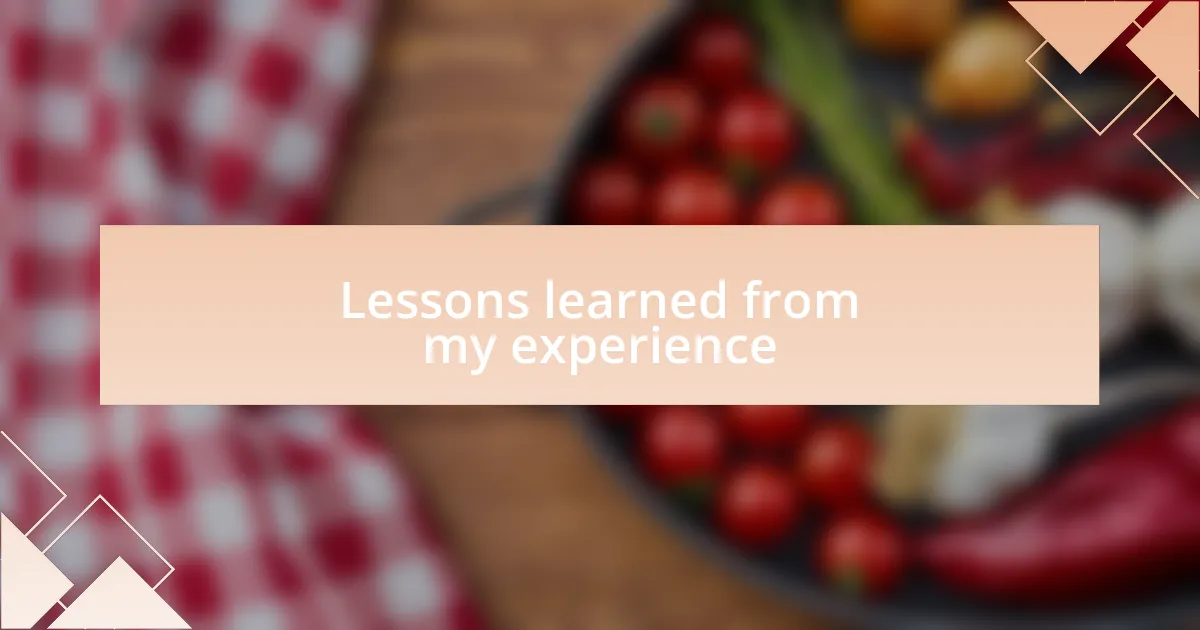Key takeaways:
- Culinary education blends art and science, enhancing appreciation for global food cultures and deepening understanding of culinary traditions.
- Modernist cuisine revolutionizes cooking by integrating scientific techniques like sous-vide and spherification, challenging traditional perceptions of food.
- Patience and precision are essential in modernist cooking, as experimentation and accurate measurements are key to mastering advanced techniques.
- Creativity in the kitchen can be amplified through modern tools, like immersion circulators and silicone molds, enabling unique presentations and flavors.

Culinary education overview
Culinary education is an exciting journey that combines both the art and science of cooking. I remember my first day in culinary school; the aroma of fresh herbs and spices filled the air, igniting a passion within me that I hadn’t fully realized before. It made me wonder, what is it about cooking that captivates us so deeply?
In many culinary programs, students often explore a range of techniques and cuisines that broaden their understanding of global food cultures. It’s fascinating to me how learning about the history and traditions behind certain dishes deepens our appreciation for them. Have you ever thought about how a simple recipe can tell a story of generations past?
Moreover, the hands-on experiences in culinary education can be incredibly transformative. I’ll never forget my first time plating a dish under the watchful eye of a professional chef. The pressure was intense, but the pride I felt when serving my creation was unmatched. Those moments not only teach technical skills but also foster a sense of creativity and expression that is vital in the culinary world. Isn’t that the beauty of cooking—being able to share a piece of yourself on a plate?

Introduction to modernist cuisine
Modernist cuisine represents a groundbreaking frontier in the culinary world, merging science with art to elevate the dining experience. I vividly recall the first time I encountered techniques like sous-vide and spherification. The sheer creativity involved left me wondering how cooking could transcend traditional methods and introduce us to a realm of flavors and textures previously unimagined.
When I started exploring modernist cuisine, I was struck by its scientific foundation. Every technique seemed to be rooted in a deep understanding of food chemistry. For instance, using liquid nitrogen isn’t just about theatrical flair; it instantly freezes ingredients, allowing for stunning presentations and unique sensations. I found myself asking, how does this change our perception of flavor?
The journey into modernist cuisine is not solely about cooking; it’s a philosophy that challenges our perceptions of food. I remember experimenting with a dish that transformed a simple carrot into a delicate foam. It became evident that this approach could evoke emotions and memories in a new light. Have you ever tasted a dish that completely redefined your expectations? This is the power of modernist cuisine, reshaping our culinary experiences and inviting endless possibilities in the kitchen.

Techniques of modernist cooking
When diving into the techniques of modernist cooking, one that captivated me immediately was sous-vide. The first time I immersed vacuum-sealed steak in a water bath, it felt like science fiction. Cooking it precisely at a low temperature resulted in such tenderness that every bite was a revelation. Have you ever cooked something for hours and felt like a culinary alchemist in the process?
Another fascinating technique is spherification, which allows you to encapsulate flavors in delicate, caviar-like spheres. I vividly recall crafting a mojito sphere for a dinner party. The moment my guests popped them in their mouths, their surprised expressions transformed into delight. It made me realize how modernist cuisine can turn simple eating into an extraordinary experience. Don’t you think it’s incredible how one tiny technique can spark such joy?
Fermentation is also a secret weapon in modernist kitchens that I deeply appreciate. I recently experimented with fermenting vegetables, which not only enhanced their flavors but also added a depth of umami that surprised everyone at my table. It made me ponder the timelessness of food preservation—how does a technique rooted in ancient practices find new life in modern cooking? The layers it adds to dishes truly showcase the beauty of intertwining tradition with innovation.

Tools used in modernist cuisine
When I first started exploring modernist cuisine, I was fascinated by the wide array of tools that chefs use to elevate their dishes. One standout device is the immersion circulator, which has become a staple in my kitchen. I remember the first time I set it up; it felt like I had unlocked a new level of culinary precision. The consistent temperature it provides ensures that my proteins cook evenly, resulting in unmatched tenderness.
Another essential tool is the blowtorch, often seen in the hands of professional chefs but surprisingly accessible for home cooks too. I still recall the excitement of using one to caramelize a dessert’s surface at home. Watching that sugar transform into a glossy, golden crust was nothing short of magical. Have you ever taken a simple dish and turned it into an impressive masterpiece? A blowtorch can do just that, adding depth and a touch of flair to your creations.
Lastly, I can’t overlook the importance of silicone molds in modernist cooking. They allow for creativity and experimentation that traditional molds simply can’t match. During one of my weekend cooking sessions, I made playful gummy confections using intricate molds. The joy I felt upon unveiling those colorful, textured treats was a testament to how these tools can inspire creativity in the kitchen. Have you ever wished to present food in a new, imaginative way? Investing in the right tools can truly transform your culinary adventures.

Lessons learned from my experience
The most significant lesson I’ve learned is the value of patience in modernist cuisine. I recall a particularly challenging dish where I attempted to create a multi-layered foam using a whipping siphon. After several failed attempts and a couple of kitchen messes, I finally nailed the technique. This taught me that experimentation and the willingness to fail are vital to mastering advanced cooking techniques.
Another insight revolves around precision in measurements. I remember when I first dabbled with spherification. I was overly confident and eyeballed the quantities without measuring them accurately. The result? A pool of liquid on my plate instead of beautiful caviar-like spheres. This experience underscored the importance of precision; in modernist cuisine, even a slight deviation can drastically alter a dish’s outcome. Have you ever underestimated the impact of precise measurements in your cooking?
Finally, I’ve come to appreciate the power of flavor pairing in this culinary style. One evening, I decided to experiment with a savory dessert by combining beetroot and chocolate. The result was a revelation that transformed how I think about ingredient combinations. It pushed me to embrace bold flavors in unexpected contexts. What flavor pairings have you discovered that changed your perspective on cooking?